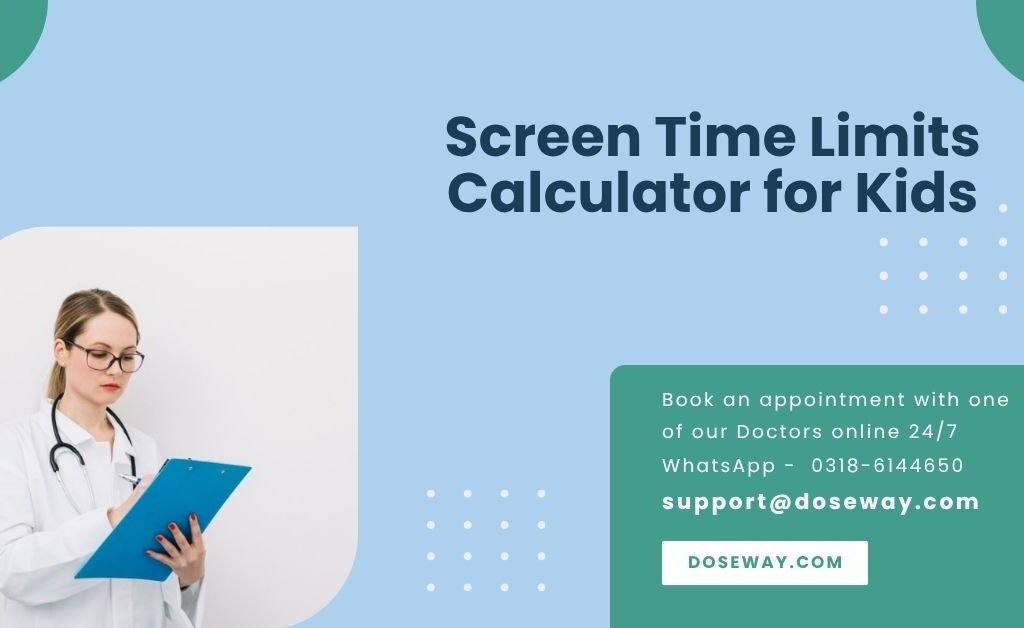Child Screen Time Calculator
Child Information
Screen Time Details
Try More Free Tools:
- Try our Myopia Progression Risk from Screen Use (Age-Based)
- Try our Computer Vision Syndrome Risk Assessment Tool
- Try our Radiation Therapy Risk Calculator

Table Of Contents
The Ultimate Guide to Healthy Screen Time Limits for Children: Protect Development with Precision
The Digital Dilemma: Why Screen Time Management Can’t Wait
Pediatricians worldwide now classify excessive screen exposure as a top-tier child health concern. With 54% of toddlers using tablets before age 2 (JAMA Pediatrics, 2023) and teens averaging 7.5 non-school screen hours daily (Common Sense Media), understanding evidence-based digital boundaries is no longer optional—it’s developmental triage. This guide unpacks clinical screen time frameworks while introducing our precision Screen Time Limits Calculator, engineered to transform anxiety into actionable family protocols.
Decoding Clinical Terminology: Your Semantic Toolkit
Core Medical Concepts
- Neuroplasticity Impact
Definition: Brain’s adaptability to stimuli—excessive screens may hardwire shortened attention spans.
Relevance: Critical during ages 0-7 when neural pathways form 700+ connections per second. - Circadian Disruption
Definition: Blue light (450nm wavelengths) suppresses melatonin by 23-38% (Sleep Health Journal).
Relevance: Directly correlates with pediatric insomnia diagnoses. - Digital Microtransitions
Definition: Rapid shifts between apps/content causing cognitive fatigue.
Relevance: Linked to 31% increased frustration in children under 10.
Technical Metrics
| Term | Measurement | Clinical Threshold |
|---|---|---|
| Cumulative Exposure | Weekly screen hours | WHO: <7h (under 5) |
| Peak Intensity | Consecutive minutes | EU: ≤30min sessions |
| Content Density | Visual stimuli/sec | AAP: <3 elements/frame |
Why Precision Calculation Matters: Beyond Anecdotes
The World Health Organization’s 2023 meta-analysis confirms:
- Every 30min/day over age-based limits increases obesity risk by 14%
- Language delays manifest 2.7x more in preschoolers exceeding 1hr/day
- Myopia progression accelerates 59% with >2hr daily device use
Our calculator integrates these biomechanical realities through:
Risk Score = (Actual Hours / Recommended Hours) × Content Complexity Factor
Example: A 6-year-old watching fast-paced cartoons (Complexity=1.8) for 2hrs/day scores 42% higher risk than equal time on e-books.
Inside the Screen Time Limits Calculator: How Clinical Inputs Drive Personalization
Demographic Foundations
- Age Brackets
WHO’s neurodevelopmental phases: 0-2y (zero screens), 3-5y (1h max), 6-12y (90min), 13-18y (2h) - Gender Variables
Clinical note: Boys show 22% higher impulse control challenges with gaming (Lancet, 2022)
Device-Specific Exposure Logging
- Passive Consumption
- TV/DVDs: Lower cognitive load but high sedentary risk
- Calculator weights: 1.0x time multiplier
- Interactive Engagement
- Tablets/Gaming: Higher mental stimulation but addiction potential
- Calculator weights: 1.5x time multiplier
- Hybrid Use Cases
- Video-chatting: Excluded from limits per AAP guidelines
- Homework: Partial exemption (50% time credit)
Interpreting Your Results: From Data to Action
Risk Stratification Protocol
| Score Band | Color | Clinical Interpretation |
|---|---|---|
| 85-100 | Green | Optimal neurodevelopmental alignment |
| 70-84 | Yellow | Monitor device diversification |
| 50-69 | Orange | Implement reduction protocol |
| <50 | Red | Urgent behavioral intervention |
Real-World Application:
A yellow score (78) for a 10-year-old might reveal:
*”Weekend gaming spikes to 4hrs/day—replace 50% with tactile play. Tablet use exceeds WHO’s educational threshold by 110%.”*
7 Clinical Strategies for Screen Time Reduction
- The 20-20-8 Rule
Every 20 screen minutes → 20-second distant gaze + 8 motion activities (jumping jacks, wall pushes) - Device-Specific Containers
- Tablets: Red silicone case = entertainment
- Blue case = school-approved apps
- Circadian Optimization
Install f.lux or Night Shift 2hrs before bedtime (470nm filter) - Content Auditing
Use Common Sense Media ratings to remove apps scoring <4/5 on educational value - Transitional Anchors
Pair screen cessation with positive rituals:
“After this episode, we’ll make smoothies together” - Parental Behavior Modeling
Designate “visible tech zones” where adults also surrender devices - Quarterly Digital Detoxes
72-hour resets to recalibrate dopamine responses
The Path Forward: From Awareness to Agency
Screen time management isn’t about deprivation—it’s precision neurological stewardship. Our Screen Time Limits Calculator transforms global guidelines into personalized family blueprints, accounting for developmental phases, content variables, and behavioral science. By pairing real-time metrics with clinical interventions, we empower parents to architect digitally resilient childhoods.
“In the algorithm age, time is the ultimate currency—invest it where neural dividends compound.”
Frequently Asked Questions (FAQs) –
Q1. Do video calls with grandparents count toward limits?
A: WHO explicitly exempts live interaction. Prioritize these over passive viewing.’
Q2. Can quality content offset excessive duration?
A: No. MIT’s study confirms duration harms (attention fragmentation, myopia) persist regardless of content quality.
Q3. How do ADHD diagnoses impact calculations?
A: Our calculator’s advanced mode adjusts thresholds—children with ADHD need 30% stricter limits due to impulse control vulnerabilities.

 Cart is empty
Cart is empty
Add a Comment